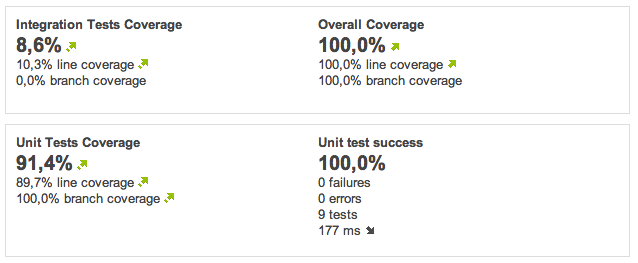I used
EasyMock framework for three years, before starting to use
Mockito two years ago and I'm now really happy with this framework.
However, it provides some features I never used, and for some features it provides several ways to write your tests. For example you have two ways to create your mocks and two ways to write your expectations.
So, in this article I will present every feature I use, and how I choose to write my Mockito tests.
Our example
Let's start with a simple example, then we will go deeper into the framework.
The class we want to test is a class managing accounts, AccountService, with a single dependency, its repository : AccountRepository. For the moment, AccountService has only one method :
public class AccountService {
@Inject
private AccountRepository accountRepository;
public Account getAccountByLogin(String login) {
try {
return accountRepository.findAccount(login);
} catch (EntityNotFoundException enfe) {
return null;
}
}
}
How can we test that with Mockito?
Mocks creation
The first thing you have to do is to create your class of test and create your mocks. I recommend to use the Mockito annotations and the Junit runner as it is more elegant and concise :
@RunWith(MockitoJUnitRunner.class)
public class AccountServiceTest {
@InjectMocks
private AccountService accountService;
@Mock
private AccountRepository accountRepository;
}
As you can see, you don't need a @Before method and you don't have to instantiate your objects. All is done automatically by the framework. To inject the mocks in the class to test, Mockito tries to do that using firstly the object constructor, then the object setters or finally the object properties.
doReturn and verify
Now let's test the method getAccountByLogin and the case where an account already exists.
private static final String LOGIN = "login";
private static final String PASSWORD = "password";
@Test
public void getAccountByLogin_withExistingAccount_shouldReturnTheAccount()
throws Exception {
// Given
Account existingAccount = new Account(LOGIN, PASSWORD);
doReturn(existingAccount).when(accountRepository).findAccount(LOGIN);
// When
Account result = accountService.getAccountByLogin(LOGIN);
// Then
assertEquals(existingAccount, result);
verify(accountRepository).findAccount(LOGIN);
verifyNoMoreInteractions(accountRepository);
}
Explanations :
- doReturn allows to override the behavior of the AccountRepository.findAccount method. Here we return an Account object to simulate the case that an account already exists
- verify(accountRepository).findAccount allows to check that this method has been called
- verifyNoMoreInteractions method allows to be sure that we didn't call another method on this mock. It is useful in that case because you test that you don't do a useless call on your repository
doThrow
Now let's test the case where the account doesn't exist. In that case the repository throws an EntityNotFoundException :
@Test
public void getAccountByLogin_withUnexistingAccount_shouldReturnNull() throws Exception {
// Given
doThrow(new EntityNotFoundException()).when(accountRepository).findAccount(LOGIN);
// When
Account result = accountService.getAccountByLogin(LOGIN);
// Then
assertNull(result);
}
As we used doReturn before, here we use doThrow method. Easy!
doReturn vs thenReturn, doThrow vs thenThrow
With mockito the following instructions are similar :
// either :
doReturn(null).when(accountService).getAccountByLogin(LOGIN);
// or :
when(accountService.getAccountByLogin(LOGIN)).thenReturn(null);
// either :
doThrow(new EntityNotFoundException()).when(accountRepository).findAccount(LOGIN);
// or :
when(accountRepository.findAccount(LOGIN)).thenThrow(new EntityNotFoundException());
However, in the case you want to test a void method, you can write :
doThrow(new EntityNotFoundException()).when(accountRepository).deleteAccount(LOGIN);
But you cannot write the following instruction because it doesn't compile :
when(accountRepository.deleteAccount(LOGIN)).thenThrow(new EntityNotFoundException());
So I recommend to always use the do* methods in order to keep your tests coherent.
Object.equals and argument captor
Now let's add another method which create an account :
public void createAccount(String login, String password) throws ServiceException {
Account account = new Account(login, password);
accountRepository.createAccount(account);
}
It seems very easy to write this test. Let's do a first try :
@Test
public void createAccount_nominalCase_shouldCreateTheAccount() throws Exception {
// When
accountService.createAccount(LOGIN, PASSWORD);
// Then
verify(accountRepository).createAccount(new Account(LOGIN, PASSWORD));
verifyNoMoreInteractions(accountRepository);
}
But unfortunately the test fails! Why? Because the verify instruction checks that the parameters passed in the createAccount method are the same in the test that in the tested code. However, in that case, the Account object has no equals method.
You may think to add an equals method in the Account object but if you do that only for your unit test, it is really a shame. Hopefully Mockito provides a cleaner way to test this case : the argument captor.
@Test
public void createAccount_nominalCase_shouldCreateTheAccount() throws Exception {
// When
accountService.createAccount(LOGIN, PASSWORD);
// Then
assertThatAccountAsBeenCreated();
verifyNoMoreInteractions(accountRepository);
}
private void assertThatAccountAsBeenCreated() {
ArgumentCaptor argument = ArgumentCaptor.forClass(Account.class);
verify(accountRepository).createAccount(argument.capture());
Account createdAccount = argument.getValue();
assertEquals(LOGIN, createdAccount.getLogin());
assertEquals(PASSWORD, createdAccount.getPassword());
}
With this technic, you can retrieve the object passed in the tested code, then do every assertion you want. Here we just want to be sure that the login and the password are correct.
Partial mocking
Now let's add three lines of code in our createAccount method to check that the account doesn't exist before we create it. To do that, we use the existing method getAccountByLogin :
public void createAccount(String login, String password) throws ServiceException {
if (getAccountByLogin(login) != null) {
throw new ServiceException(String.format("The account %s already exists", login));
}
Account account = new Account(login, password);
accountRepository.createAccount(account);
}
As you have already tested the getAccountByLogin, you don't want to test it again because our tests could become unmaintainable.
So here you can use the partial mocking. The idea is to mock the call to the getAccountByLogin method within the class you are testing. With Mockito (unlike other mock frameworks) it is very easy to do that. You just have to override your method behavior like if you were using a mock :
@Test
public void createAccount_nominalCase_shouldCreateTheAccount() throws Exception {
// Given
doReturn(null).when(accountService).getAccountByLogin(LOGIN);
// When
accountService.createAccount(LOGIN, PASSWORD);
// Then
assertThatAccountAsBeenCreated();
verifyNoMoreInteractions(accountRepository);
verify(accountService).getAccountByLogin(LOGIN);
}
Then you just have to add the @Spy annotation on the declaration of your tested object :
@InjectMocks
@Spy
private AccountService accountService;
And it works!
Conclusion
I think I covered every feature of Mockito I use every day. Don't hesitate to ping me if I forgot something important. Anyway, I hope this tutorial helped you to have a better understanding of this great framework!
The whole code, with more cases and tests, is available on
my github account.
Also, don't hesitate to consult
my recommendations to write maintainable unit tests.
Cheers!
